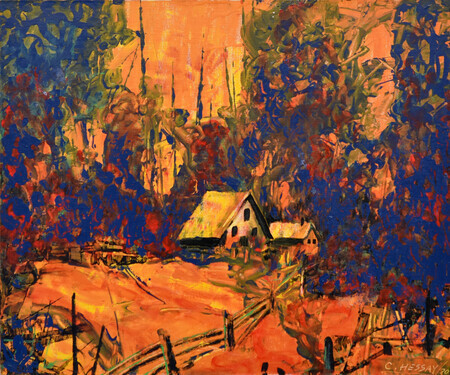Carle Hessay 1970 Homestead in the Woods

Carle Hessay: Homestead in the Woods
"The painting depicts two cabins, seemingly abandoned, as shown by the holes in place of windows and the disrepair of the fences in the foreground. The enclosed open clearing, with a path leading to some barnlike structures in the distance, suggests it may have been a livestock farm.
What is most striking, apart from the bright orange comprising large patches of field and sky, is that the entire background appears to be engulfed in a cataclysm of some sort. It could be simply a forest fire, indicated by the charred black trunks reaching upwards. The loose brushwork of layered colours, greens, reds, and blues, swirling and flowing, swallow the trees, which are merely inferred by position. The firestorm seems to engulf and surround the dwellings, yet they still appear surprisingly intact, even as the orange and blue flickering is advancing upon them. Perhaps we’re not looking at an event of physical destruction so much as a psychological or spiritual calamity.
The heightened emotional key of orange is certainly in keeping with the tradition of German expressionism. However, in a chameleon-like way, when the painting is viewed in stronger light than indoors, such as outside on a cloudy day, a transformation occurs. The blue within the storm now startles by its vividness, becoming almost phosphorescent, on par with the orange. The painter Emil Nolde described one of his colour varieties as “blue thunder”, an apt description of the role it plays in this painting.
The curious blue colour hints that it may not have originated in a tube. Carle often foraged in the B.C. interior for sources of pigment. The blue could be derived from the mineral vivianite, a source known to First Nations people, and unstable in sunlight. Whatever its ancestry, the interplay of orange and blue, opposites on the colour wheel, creates a dynamic yet harmonious whole."
(Commentary by Walter James Burton)
(Dimensions: 19.8 x 23.9 inches; 50.4 x 60.7 cm.; oil on canvas board; 1970)

